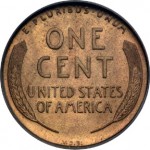The red hats hang from the ceiling of St. Patrick’s Cathedral, high above the sanctuary. Each galero-a circular, broad-brimmed hat, ornamented with thirty tassels of scarlet thread interwoven with gold, fifteen to a side-denotes that the cardinal who possessed it had once possessed the cathedral and held jurisdiction over the Catholic people of New York. In the old days, he would have received it from the hands of the pope. The new cardinal, vested with a scarlet, watered-silk cappa magna—the great cape warn by cardinals for more than a thousand years—was led to the Sistine Chapel. He reverenced the Divine Presence on the altar and the enthroned pope. At this point, as Peter C. Van Lierde wrote in his 1964 book, What is a Cardinal?:
After kissing the Pontiff’s hands and cheek…the Cardinals-elect prostrated themselves on the floor before the altar while the Pope read prayers over them. Then…the Pope recited in Latin: ‘To the praise of Almighty God and the honor of His Holy See, receive the red hat, the distinctive sign of the Cardinal’s dignity, by which is meant that even unto death and the shedding of blood you will show yourself courageous for the exaltation of our Holy Father, for the peace and outlet of Christian people, and for the augmentation of the Holy Roman Church. In the name of the Father and of the Son and the Holy Ghost.’
The galero was then presented to the new cardinal. He never wore it again. Later, it would be carried before his coffin, placed at the foot of his bier and finally hung from the ceiling of his cathedral.
Six of the eight archbishops of New York have been cardinals: John McCloskey, John Farley, Patrick Hayes, Francis Spellman, Terence Cooke and John O’Connor. If the first archbishop, John Hughes-the charming, eloquent, self-educated, adamantine “Dagger John,” as obnoxious to the Establishment of his day as Al Sharpton to ours-had lived a little longer, one imagines Pius IX would have granted him the red hat. Michael Augustine Corrigan, the third archbishop, also did not receive the hat. He reigned from 1885 until 1902. An honest, hardworking, competent administrator, His Excellency perhaps lacked finesse in personal and political relations. One imagines Leo XIII was unimpressed when Corrigan excommunicated one of his own priests, Father Edward McGlynn, for reasons rooted in politics. McGlynn was a radical firebrand with a hob-lawyer’s genius for remaining just this side of canon law. During the mayoral campaign of 1886, Corrigan forbade him to speak in support of the United Labor candidate, Henry George.
Nonetheless, on at least one occasion McGlynn appeared on George’s platform without speaking, having first ensured that all present knew Corrigan had silenced him. It was merely one of McGlynn’s many provocations. When Corrigan rose to the bait and not only suspended McGlynn’s faculties as a priest but excommunicated him, bell, book and candle, McGlynn appealed to Rome. Then as now, Rome takes its time in these matters. Five years later, in 1891, Rome ordered McGlynn’s reinstatement. Corrigan was utterly humiliated. Nonetheless, he obeyed Rome as he had expected McGlynn to obey him, without delay or reservation. Peace to an honest man.
To describe a cardinal as a prince of the church merely states a fact. We sometimes forget that the popes wielded temporal power until 1870, when Vittorio Emmanuele II completed the unification of Italy by the seizure of Rome. Both the Congress of Vienna and the Congress of Berlin confirmed, and the Treaty of Versailles in 1918 ratified, that membership in the Sacred College of Cardinals carried with it diplomatic status equal to that of princes of the blood royal. As such, cardinals took official precedence behind emperors, kings, and their immediate heirs, or heads of state. No other person ever outranks a cardinal. Since at least the 17th century, all cardinals have enjoyed the title and dignity of “Eminence.” Thus, in conversation, he is addressed as “Your Eminence”; in formal communications, he is addressed as Most Eminent Lord or Most Eminent Cardinal.
Today precedence is generally a question of protocol, the rules governing the political and social relationships of nations and the people who represent them. As with all codes of etiquette, protocol creates a sense of order in both the ceremonial and the mundane. It is considerably more than the question of the rank of the person receiving a cardinal at the airport, the number of troops in the honor guard or the number of salvoes in an artillery salute. Nonetheless, many cardinals, particularly the Americans, find their princely status uncomfortable. One might think that such a thing was in itself a kind of ostentatious false humility—another manifestation of the capital sin of pride by seeking to substitute one’s uninformed emotional response for the measured judgment of the centuries—but perhaps one is mistaken.
These thoughts were prompted while listening to a garrulous Catholic lawyer acquaintance recount his observations of one of the late cardinal-archbishop’s several funeral Masses. The Cardinal died on a Wednesday around 8 p.m. By Friday evening, dressed in full canonicals, he was lying in state at the cathedral. As he had promised, the coffin bore a union label. My friend was also in attendance, wearing a white mantle and black velvet beret, the ceremonial regalia of a Knight of the Equestrian Order of the Holy Sepulchre of Jerusalem. He was only one of several hundred colorfully dressed persons: the congregation included black-robed Knights of Malta; Franciscan monks in roped gray robes and sandals; bishops in violet; monsignors in black cassocks piped in red; Capuchins in brown; Dominicans in white; and nuns of several orders in their habits.
This was a pale echo of the exotic and flamboyant presences at Francis Cardinal Spellman’s funeral more than thirty years ago. Vatican II and the blanding of the church in America had not begun to take effect (Spellman had sworn to stop the reforms at the water’s edge, and unlike Canute had held back the tide during his lifetime). Then, the Knights of Malta wore red tunics with epaulettes and cocked hats with ostrich plumes. The Knights of the Holy Sepulchre wore white tailcoats “with collar, cuffs, and breast facings of black velvet with gold embroideries, epaulettes of twisted gold cord, white trousers with gold side stripes, a sword, and a plumed cocked hat,” according to Peter Bander van Duren, in Orders of Knighthood and of Merit.
My friend received this honor some years ago for reasons as mysterious to him as to me. This is the kind of distinction for which one does not apply. One must be invited. An acquaintance surprised him by quietly asking whether he would accept a papal knighthood. “I was restrained in my enthusiasm,” my friend said. “I waited three whole seconds before saying, ‘Yes.'” We celebrated his knighthood with a symposium in a local watering hole. After all, symposium comes from the Greek for “drinking party.”
The Order of the Holy Sepulchre is among the last of the Crusader orders of knighthood. It is probably at least 1,000 years old: some historians claimed with more enthusiasm than documentation that the Order might have existed in one form or another before the end of the first century of the Christian era. With the loss of the Latin Kingdom of Jerusalem, the Order gradually came under the protection of the Roman Church.
At one time, its knights enjoyed many privileges, “some of which were of a rather peculiar character,” notes James Vander Velde in The Pontifical Orders of Knighthood. “They had precedence over members of all orders of knighthood, except those of the Golden Fleece. They could create notaries public or change a name given in baptism; they were empowered to pardon prisoners whom they happened to meet while the prisoners were on their way to the scaffold…” They also had the privilege of legitimizing bastards. In New York, this notion may need reviving: there is so much work to do.
Unfortunately, there are no records of the first American knights of the Equestrian Order. One might reasonably speculate they were immigrants who had served in the papal armies. For example, Myles Keogh, a man who went in harm’s way, fought against Garibaldi’s forces at Ancona with the Pontifical Battalion of St. Patrick in 1860; during the War Between the States, he rose to the rank of colonel in the Union army. He then joined the Papal Zouaves and was knighted by Pius IX for valor. He rejoined the U.S. Cavalry and died with Custer at the Little Big Horn.
Popes granted not merely decorations but titles of nobility. Thus, Genevieve Brady, the wife of Nicholas Brady, a turn-of-the-century utility magnate, was ennobled by Pius XI as the Duchess Brady. The descendants of Edward Hearn, a successful contractor turned fundraiser, may still use the title of “Count.”
If one enters Fordham Law School, a large bronze wall plaque lists the benefactors whose generosity enabled the construction of the Lincoln Center campus of the Jesuit University of New York. Among them is George, Marquis MacDonald. If memory serves, he had begun as a contractor, became a spectacularly successful financier, and then a benefactor of the church. He had married a daughter of the infamous police inspector Thomas Byrnes, whose personal fortune came from sources best left unexamined. MacDonald became a Knight of Malta, a Knight Grand Cross of the Holy Sepulchre, a Knight Grand Cross of the Order of St. Gregory the Great, the holder of numberless honorary doctorates and, much to his pleasure, a papal marquis. He loved to have his picture taken in the uniform of one or another of these orders.
Titles, decorations, uniforms: these things have a certain romantic charm. But even my old lawyer friend noticed the important thing. During the Order’s ceremonies, the reading that most moved him is from Ecclesiastes:
Remember your Creator in the days of your youth, before the evil days come And the years approach of which you will say, I have no pleasure in them… Before the silver cord is snapped and the golden bowl is broken, And the pitcher is shattered at the spring, and the broken pulley falls into the well, And the dust returns to the earth as it once was, And the life breath returns to God who gave it. Vanity of vanities, saith the prophet, All is vanity.
New York Press, May 30, 2000
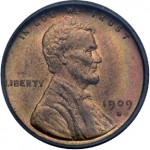
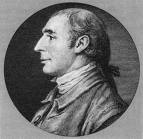 In 1782, Gouverneur Morris wrote a report describing the “perplexing…and troublesome” exchange rates among state currencies. He suggested a federal mint and a national coinage that would reconcile the different state currencies with an extremely complicated system involving a common denominator of 1,440 units.
In 1782, Gouverneur Morris wrote a report describing the “perplexing…and troublesome” exchange rates among state currencies. He suggested a federal mint and a national coinage that would reconcile the different state currencies with an extremely complicated system involving a common denominator of 1,440 units.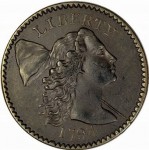

 the designer, James Longacre, apparently popped an Indian headdress on his pretty daughter Sara. But charming Sara was merely a model for an allegory. Placing an historical person on a coin was seen as monarchical and inappropriate for a republic. This suited the Mint bureaucracy, who seemed more concerned about whether their coins would stack for easy counting than their physical beauty.
the designer, James Longacre, apparently popped an Indian headdress on his pretty daughter Sara. But charming Sara was merely a model for an allegory. Placing an historical person on a coin was seen as monarchical and inappropriate for a republic. This suited the Mint bureaucracy, who seemed more concerned about whether their coins would stack for easy counting than their physical beauty.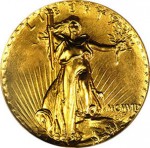 The sculptor and the statesman collaborated to make coins beautiful. Their triumph is Saint-Gaudens’ “Standing Liberty” twenty-dollar gold piece, first struck in 1907. On the obverse, a voluptuous Liberty holds aloft in her right hand the torch of Enlightenment and in her left the olive
The sculptor and the statesman collaborated to make coins beautiful. Their triumph is Saint-Gaudens’ “Standing Liberty” twenty-dollar gold piece, first struck in 1907. On the obverse, a voluptuous Liberty holds aloft in her right hand the torch of Enlightenment and in her left the olive 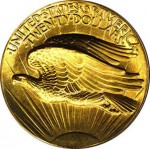 branch of peace. On the reverse, an eagle soars above a sun rising in glory. Saint-Gaudens died before he could design a new cent. Roosevelt had another artist for the job.
branch of peace. On the reverse, an eagle soars above a sun rising in glory. Saint-Gaudens died before he could design a new cent. Roosevelt had another artist for the job.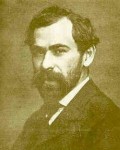 In 1908, Brenner was commissioned to create a bronze plaque for the centennial of Lincoln’s birth in 1909. Around the same time, the Panama Canal Commission also retained him to design a medal. Its obverse would bear President Roosevelt’s profile. T.R. posed at Brenner’s studio. The President openly admired the plaster patterns for the Lincoln plaque and later suggested to his secretary of the treasury that Brenner’s portrait of Lincoln should appear on a coin. Consequently, Brenner was the only person invited to participate in formulating the new design, much to the chagrin of Charles Barber.
In 1908, Brenner was commissioned to create a bronze plaque for the centennial of Lincoln’s birth in 1909. Around the same time, the Panama Canal Commission also retained him to design a medal. Its obverse would bear President Roosevelt’s profile. T.R. posed at Brenner’s studio. The President openly admired the plaster patterns for the Lincoln plaque and later suggested to his secretary of the treasury that Brenner’s portrait of Lincoln should appear on a coin. Consequently, Brenner was the only person invited to participate in formulating the new design, much to the chagrin of Charles Barber.